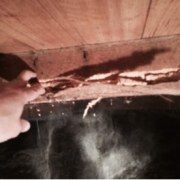Self Diagnosing Termite Issues
Termites are considered to be a bigger threat to structural damage in Australian houses than any other factor – more than wind, fire and flooding. However these pests are very secretive and are almost always difficult to detect to the untrained eye. In many cases, termites find their way into homes without being detected until a pre-purchase inspection, renovations or substantial damage reveals the problem.
The primary type of termite which has the biggest effect on structures around Melbourne and other parts of Australia are subterranean termites. These colonies live underground in loose, damp soil, or often in the base of large trees, up to 50 metres away from an infested building. They are also known to build colonies in walls or furniture if there’s enough moisure, and there are many telltale signs which can point to a termite infestation.
Because termites mostly live underground and in the walls of a home, it is unlikely that the termites themselves will be seen. However some signs to look for include:
Mud tubes on exterior surfaces of stumps or concrete slab foundations.
Termites build these tunnels to protect themselves from the elements and are able to traverse from the food source to nest without being disturbed.
Discarded wings from flying termites
Wings from flying termites such as alate caste are all the same size and look silvery or translucent. You might find piles near windows, doors or other entry points after warm, humid weather.
Termite Droppings
These look like small, wood coloured pellets and can be found if damage is located within a home.
Damaged timber and messy debris
Subterranean termites often leave a corrugated or honeycombed look inside timber, mixed with mud and soil.
A check for existing damage would include looking for any buckling or hollow sounding floor or wall timber when you knock on it (especially if access is possible to sub-floor or roof voids). Doors and windows may become difficult to open when infested, as tunnelling termites can warp the frames. Many foundations these days are made of concrete, and although termites do not eat concrete, they are able to burrow through very small cracks within brickwork or other cladding to gain access to timber floor joists and bearers. Once they are inside the boundary walls, a colony is able to spread throughout a structure quickly and easily feasting on the accessible timber without being detected.
For buyers and sellers, timing matters. Flying termites often appear around dusk after warm, humid conditions in late spring and summer. Renovation work and leak repairs also tend to uncover hidden issues, so keep an eye out when opening up walls or floors.
Self Diagnosing a termite infestation can be tempting in order to save a little money, however there is a risk that missing signs of an infestation and may cause bigger structural issues in the future. It is always therefore recommended that if you suspect termites may be present, a professional with the necessary training should be engaged to confirm whether an infestation is present. The risks of missing a termite problem greatly outweigh the short term benefits you will get from trying to diagnose the problem yourself.
Simple Prevention tips for Melbourne Homes:
- Keep drainage and ventilation in good shape. Fix leaks and keep garden beds and mulch below slab edges and damp-proof course.
- Reduce timber-to-soil contact. Don’t store firewood or untreated timber against the house and replace decaying landscaping timbers.
- Keep weep holes and vents clear so you can see any mudding.
- Arrange regular inspections.
In you are considering purchasing a property, or simply require a check of your own property, Melbourne House Check conduct building and pest inspections Melbourne wide. Call us on 1300 729 352 for a quote or discussion on your requirements.
Read our other articles on termite inspections and termite damage
Is your house at risk of termite infestation?
Termite infestation in a new home under 2 years old
Building inspections also look for termites





